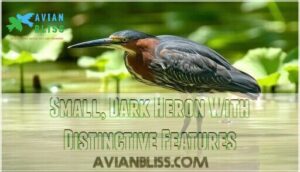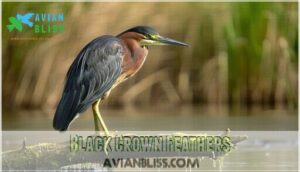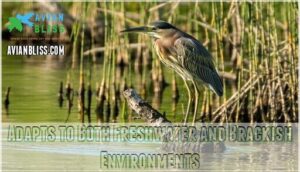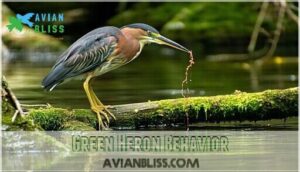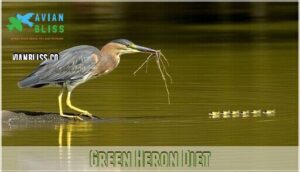This site is supported by our readers. We may earn a commission, at no cost to you, if you purchase through links.

This clever wading bird breaks the mold among herons—it’s a master tool-user that drops feathers, twigs, or insects onto water surfaces to lure unsuspecting fish within striking range.
Found throughout North America’s shallow wetlands, from quiet ponds to marshy shorelines, these secretive hunters prefer dense vegetation where they can disappear until the perfect moment arrives.
Their dark greenish-blue backs shimmer in sunlight, while their problem-solving abilities rival those of much larger birds.
The green heron’s innovative hunting techniques reveal surprising intelligence that challenges traditional views of avian behavior, showcasing their clever nature and striking appearance.
Table Of Contents
- Key Takeaways
- Green Heron Identification
- Green Heron Habitat
- Green Heron Behavior
- Green Heron Diet
- Green Heron Range and Conservation
- Frequently Asked Questions (FAQs)
- How rare is it to see a green heron?
- What is the difference between a green heron and a night heron?
- How rare are Green Herons?
- How do you identify a Green Heron?
- In what states do Green Herons live?
- What is the difference between a blue heron and a Green Heron?
- Where do green herons live?
- What does a green heron sound like?
- What does a green heron look like?
- How old is a green heron?
- Conclusion
Key Takeaways
- You’ll spot green herons by their compact 16-22 inch frame, chestnut neck, and distinctive orange-yellow legs – making them much smaller and more colorful than great blue herons you might expect to see
- You’re witnessing one of nature’s smartest hunters when you watch green herons use tools – they’ll drop feathers, twigs, or insects as bait to lure fish within striking range, showing problem-solving skills that rival some primates
- You’ll find these secretive birds hiding in shallow, vegetated wetlands throughout North America – from backyard ponds to vast marshes, where they prefer water less than four inches deep for optimal hunting
- You’re supporting green heron survival when you protect wetland habitats – their populations have declined 51% since 1966 due to habitat loss, making wetland conservation critical for these remarkable tool-using birds
Green Heron Identification
You’ll recognize a green heron by its compact, hunched appearance and distinctive coloring that sets it apart from larger heron species.
This small, stocky bird features bright orange-yellow legs, a rich chestnut neck, glossy dark crown feathers, and an iridescent dark back that shimmers with green or blue highlights in sunlight.
Small, Dark Heron With Distinctive Features
The green heron’s compact size immediately sets it apart from larger wading birds you’ll encounter.
This small heron measures just 16-18 inches with distinctive feather colors ranging from slate-blue bodies to chestnut necks.
Its sharp beak shape perfectly complements patient hunting strategies, while sturdy leg structure supports stealthy movements through shallow waters.
The bird’s 25-26 inch wing span seems modest compared to great blue herons, yet it’s perfectly proportioned for traversing dense vegetation where this heron bird thrives, utilizing its sharp beak shape and sturdy leg structure.
Orange-yellow Legs
Look beyond the green heron’s compact frame to spot its most reliable field mark: those distinctive orange-yellow legs.
Unlike other heron species with darker limbs, this bird’s leg coloration shifts from bright yellow to vibrant orange during breeding season.
The yellow pigment becomes more pronounced as hormones surge, creating an orange hue that’s unmistakable among wetland bird species in suitable heron habitat.
Chestnut Neck
If you spot a heron with a chestnut neck, you’re likely observing a classic green heron trait.
This rich, rusty hue stands out among bird markings, especially during breeding season, when plumage variation becomes more pronounced.
Neck coloration helps with species identification in the field, revealing key feather patterns and breeding traits unique to this bird species in its preferred heron habitat.
Black Crown Feathers
Above the chestnut neck, you’ll notice the green heron’s distinctive black crown feathers that can be raised into a sharp crest when the bird feels threatened or excited.
This crown pattern creates a sleek silhouette against wetland backdrops.
The feather coloration appears jet-black in most lighting, though close observation reveals subtle iridescent sheen during peak sunlight.
These plumage texture variations help with bird identification, as the crown’s ability to flatten or spike distinguishes green herons from similar species during heron behavior observations.
Dark Back Glossed With Green or Blue
What distinguishes this compact heron’s feather coloration from other waterbirds?
The green heron’s dark back displays a stunning iridescent sheen that shifts between deep green hue and subtle blue tint depending on lighting conditions.
This glossy plumage creates nature’s own color-changing magic, helping with camouflage while adding beauty to heron behavior.
The iridescent quality makes identification easier for birdwatchers seeking these secretive hunters.
Green Heron Habitat
You’ll find green herons in shallow wetlands throughout North and Central America, from small backyard ponds to vast marshes and swamps.
These adaptable birds choose nesting sites 5-30 feet above ground in shrubs or trees near water edges, preferring areas with dense vegetation that provides cover while they hunt in water less than four inches deep.
Lakes, Ponds, Marshes, Swamps, Streamsides
Green herons frequent diverse freshwater ecosystems where water quality supports abundant prey populations.
These adaptable water birds thrive in environments with healthy aquatic plants and minimal shoreline erosion.
You’ll find green herons in:
- Shallow marshes – Dense vegetation provides perfect hunting cover
- Quiet pond edges – Still water reveals unsuspecting fish below
- Wooded swamp areas – Overhead canopy offers excellent concealment
- Stream backwaters – Slow-moving sections concentrate small prey
- Vegetated lake margins – Aquatic plants attract insects and minnows
Wetland conservation efforts directly benefit these clever wading birds, as they depend on pristine habitats where aquatic birds can flourish alongside diverse shore birds. Understanding unique bird habitats is essential for effective conservation of green heron populations.
Nests in Shrubs or Trees 5-30′ Above Ground
In terms of nest placement, you’ll often find herons picking shrubs or trees 5 to 30 feet above ground.
This nest height isn’t random—it’s about branch stability and nest camouflage.
Tree selection is strategic, offering protection from predators and weather.
Heron nesting pairs fiercely guard their nesting territory, ensuring their chosen nest site remains secure and undisturbed, which is crucial for their nest site.
Prefers Shallow, Vegetated Shorelines
You’ll find green herons stationed along shallow, vegetated shorelines where water depth rarely exceeds four inches.
These wetland birds prefer aquatic habitats with dense aquatic vegetation that provides cover while hunting, and they seek freshwater environments with emergent plants and submerged structures.
The shallow wetlands offer perfect hunting grounds where shoreline structure includes overhanging branches and thick vegetation types like cattails and sedges, which provide the necessary cover for these birds.
Adapts to Both Freshwater and Brackish Environments
Unlike many waterbirds that stick to one water type, you’ll discover the green heron’s remarkable Environmental Flexibility allows it to thrive in diverse Aquatic Habitats.
This Water Adaptation gives them access to:
- Freshwater ponds and marshes
- Brackish coastal wetlands
- Saltwater estuaries and mangroves
- Urban water features and canals
- Seasonal flood zones
Their Aquatic Resilience means whether you’re exploring Freshwater Habitats or Brackish Zones, these versatile hunters make themselves at home wherever fish swim, showcasing their ability to adapt to various Aquatic Habitats.
Green Heron Behavior
If you’ve ever watched a green heron hunt, you’ll notice it’s one of nature’s most patient and clever predators.
These secretive birds use remarkable problem-solving skills, including dropping twigs or feathers as bait to lure unsuspecting fish within striking range, showcasing their clever hunting tactics.
Uses Bait to Lure Fish
You’ll witness one of nature’s most remarkable fishing strategies when you observe green herons deploying bait to attract their prey.
Master anglers of the wetlands—green herons drop feathers as bait, proving birds can fish smarter, not harder.
These clever birds drop twigs, feathers, or insects onto the water’s surface, creating irresistible lures that draw curious fish within striking distance.
The use of artificial fishing lure types can provide insights into the effectiveness of different bait.
| Bait Type | Effectiveness |
|---|---|
| Feathers | High success rate |
| Small twigs | Moderate success |
| Insects | Variable results |
| Bread crumbs | Urban adaptation |
| Flower petals | Seasonal use |
This toolusing behavior demonstrates sophisticated prey capture techniques that few bird species master, making green herons exceptional hunters.
May Nest as Isolated Pairs or in Small Groups
You’ll find green herons follow flexible breeding patterns that break traditional bird nesting rules.
While many species stick to large colonies, green herons chart their own course. These adaptable birds nest either as isolated pairs seeking privacy or form small, loose groups when prime habitat brings them together.
Their nesting habits reflect practical decision-making rather than rigid social behavior.
- Pair bonding occurs through elaborate courtship displays involving neck stretching and bill snapping
- Breeding patterns vary based on local habitat quality and available nesting sites
- Group dynamics remain loose even when multiple pairs nest nearby
- Social behavior centers on territorial defense rather than cooperative breeding
- Wildlife refuge areas often support small nesting colonies due to protected, ideal conditions
Solitary and Secretive
Although green herons are generally social during breeding seasons, they transform into solitary, secretive creatures outside mating periods.
You’ll rarely spot these elusive birds in groups, as their heron behavior favors independence over community living.
Their secretive nature and advanced camouflage techniques make them masters of stealth, essential for bird conservation efforts monitoring their territorial marking and nesting habits.
Understanding solitary bird habitats, such as those found in Solitary Bird houses, is essential for studying their behavior.
Perches on Low Branches or in Dense Vegetation
You’ll discover green herons are masters of stealth, choosing strategic perching positions that maximize their hunting success while maintaining perfect camouflage.
Green Heron Branch Preference & Vegetation Choice:
- Low-hanging branches 3-16 feet above water provide ideal ambush points
- Dense shoreline tangles offer concealment from both predators and prey
- Emergent vegetation like reeds serves as backup perching when trees aren’t available
- Overhanging willows create natural hunting blinds with easy water access
- Thick mangrove clusters support both roosting behavior and nesting habits
This tree selection strategy transforms ordinary wetland edges into hunting headquarters, where patient herons blend seamlessly into their surroundings. The green heron’s use of wetland habitats is essential for its survival and hunting success.
Hunts by Standing Still and Waiting for Prey
Green herons master the art of patient hunting through stealth mode tactics.
You’ll observe them standing motionless for extended periods, becoming living statues at water’s edge.
This stalking prey technique proves remarkably effective—they wait in shallow water under four inches deep, where their success rate peaks.
Their foraging strategy combines standing still with slow, deliberate movements, demonstrating patient hunting skills that rival any predator’s bait fishing expertise.
The green heron’s behavior exhibits remarkable examples of fascinating bird behaviors that aid in its hunting success.
Green Heron Diet
You’ll find green herons aren’t picky eaters, hunting everything from minnows and crayfish to frogs and even small rodents along shallow water edges.
What makes them truly remarkable is their tool-using behavior—they’ll drop feathers, twigs, or insects onto the water’s surface as bait to lure unsuspecting fish within striking range.
Fish, Crayfish, Aquatic Insects, Frogs, and Small Rodents
You’ll find green herons targeting diverse aquatic food sources during their patient hunting strategies.
Their heron diet includes small fish like minnows and sunfish, plus crayfish that scuttle along muddy bottoms.
These skilled hunters also capture aquatic insects, frogs, and tadpoles through precise prey capture techniques.
Small vertebrates like rodents and snakes round out their menu, showcasing their adaptable fishing tactics in shallow wetland environments, utilizing their patient hunting strategies.
Catches Fish, Frogs, Insects, and Small Mammals
These skilled hunters capture a diverse menu through precise prey capture techniques and strategic hunting tactics.
You’ll observe them targeting specific species based on water conditions and seasonal availability.
Primary targets in their heron diet:
- Fish – minnows, sunfish, catfish, perch, and goldfish in shallow waters
- Aquatic insects – beetles, water bugs, and larvae near vegetation edges
- Frogs – tadpoles and small amphibians along muddy shorelines
- Small rodents – mice and voles near water sources during low-light hours
Their success rates peak in waters under four inches deep, where their dagger-like bills deliver lethal strikes with surgical precision.
Known for Using Tools Like Feathers or Insects to Lure Prey
When you spot a Green Heron fishing, you’ll witness one of nature’s most fascinating hunting techniques.
These clever birds deliberately drop feathers, insects, or twigs onto water surfaces to lure fish within striking range – a rare example of avian tool use that dramatically improves their Baiting Success rates.
The use of effective bird bait tools is essential for their hunting success, utilizing bird bait methods.
| Common Bait Types | Tool-Use Frequency |
|---|---|
| Feathers, insects | Up to 10 attempts/hour |
| Bread crumbs, twigs | Varies by individual |
| Flower petals, berries | Seasonal availability |
| Small crustaceans | Natural prey items |
This sophisticated feeding behavior showcases remarkable Learning Behavior, as juveniles observe and imitate adults’ hunting techniques, gaining an Evolutionary Advantage through improved Prey Specialization.
Demonstrates Problem-Solving Skills and Tool Use in Hunting
Watch green herons transform from patient hunters into creative problem-solvers, displaying remarkable intelligent behavior that rivals some primates.
Their bait fishing techniques demonstrate sophisticated tool use, employing feathers, twigs, and insects as lures with calculated precision.
Three fascinating problem-solving skills you’ll witness:
- Strategic bait selection – They choose specific items based on water conditions and prey type
- Adaptive hunting tactics – Switching between stealth and active baiting when initial approaches fail
- Memory-based tool use – Returning to successful hunting spots with preferred lures, showing learning retention
The green heron’s diet consists of various food sources, including insects, which are a vital part of bird dietary needs.
Green Heron Range and Conservation
You’ll find green herons across North and Central America, from southern Canada down to Panama, with year-round populations in Florida, the Gulf Coast, and Mexico.
Their numbers depend heavily on wetland health and water quality, making habitat loss their biggest conservation challenge as development continues to shrink the shallow, vegetated shorelines they need to survive, which is heavily influenced by water quality.
Found in North and Central America
You’ll discover these remarkable birds across a vast Geographic Range stretching from southern Canada to northern South America.
Green Heron populations showcase incredible Habitat Diversity, thriving in wetland ecosystems from coastal mangroves to inland streams, making bird watching adventures rewarding throughout North America.
The Green Heron’s unique behavior is characterized by its use of fishing tool tactics to catch prey.
| Region | Breeding Status | Migration Patterns |
|---|---|---|
| Southern Canada | Summer breeding | Migrate south in fall |
| Eastern U.S. | Breeding populations | Partial migration |
| Gulf Coast | Year-round residents | Limited movement |
| Central America | Permanent residents | Non-migratory |
| West Indies | Year-round populations | Seasonal dispersal |
Year-Round Presence in Florida, Gulf Coast, and Mexico
You’ll find green herons calling these warm regions home throughout the entire year, making them reliable neighbors in southern wetlands.
These adaptable birds have carved out permanent territories where winters stay mild and prey remains abundant.
- Florida Habitats: Thriving in Everglades marshes, coastal mangroves, and freshwater ponds
- Gulf Coast Migration: Staying put while northern relatives head south for winter
- Mexico Wetlands: Establishing year-round populations in coastal lagoons and inland waterways
Seasonal Expansion in Spring to Eastern U.S
Each spring, green heron migration patterns bring these clever birds northward from their southern wintering grounds.
You’ll spot them expanding their eastern range into New England and the upper Midwest as seasonal movements guide them to prime breeding grounds.
This North American bird’s spring habitats include freshwater wetlands where they’ll establish territories.
Range maps show their remarkable journey from overwintering sites to northern breeding areas, demonstrating nature’s perfectly timed seasonal rhythm.
Population Distribution Tied to Wetlands and Water Quality
Green heron populations mirror the health of our freshwater wetlands like living barometers.
You’ll find these clever birds thriving where water quality remains pristine and aquatic vegetation flourishes.
Water pollution and ecosystem imbalance directly impact their numbers, making wetland conservation essential for maintaining biodiversity. Their distribution patterns reveal which habitats support robust bird conservation efforts.
Habitat Loss Identified as a Major Conservation Concern
Unfortunately, wetland destruction continues threatening green heron populations across their range.
Habitat loss represents the primary conservation challenge, with surveys documenting a concerning 51% population decline since 1966.
The green heron’s survival is also impacted by habitat loss effects on its ecosystem.
Five Critical Threats to Green Heron Survival:
- Wetland Destruction – Agricultural drainage eliminates essential breeding habitats
- Habitat Fragmentation – Urban development isolates remaining wetland patches
- Ecosystem Decline – Poor water quality reduces prey availability
- Biodiversity Loss – Simplified habitats can’t support complex food webs
- Conservation Status concerns prompt targeted wetland conservation efforts nationwide
Frequently Asked Questions (FAQs)
How rare is it to see a green heron?
Looking for these secretive waders requires patience—they’re spotted less than 20% of the time during targeted bird surveys.
You’ll find them hiding along vegetated shorelines, perfectly camouflaged and motionless, making detection challenging despite their widespread distribution.
What is the difference between a green heron and a night heron?
You’ll spot key differences in size, posture, and coloring between these herons.
Night herons are stockier with shorter necks, while green herons appear more compact and hunched when perched at water’s edge.
How rare are Green Herons?
You’ll spot these compact waders frequently across North America.
Partners in Flight estimates the global breeding population at 2 million and considers them relatively low conservation concern, though populations are declining range-wide.
How do you identify a Green Heron?
You’ll recognize this compact heron by its distinctive slate-blue body, rusty chestnut neck, and dark cap that creates a hunched appearance when perched along water’s edge.
In what states do Green Herons live?
These feathered neighbors aren’t confined to distant wilderness—you’ll find Green Herons across most eastern and southern states year-round, from Florida’s Gulf Coast through Texas, plus seasonal visitors throughout the Midwest and Northeast during spring breeding.
What is the difference between a blue heron and a Green Heron?
Blue herons tower at four feet tall with gray plumage.
While you’ll find Green Herons are compact at eighteen inches with iridescent green backs and chestnut necks—they’re entirely different species, with iridescent green backs being a distinctive feature.
Where do green herons live?
You’ll find these versatile birds throughout North America’s wetlands, from Florida’s year-round marshes to seasonal breeding grounds reaching southern Canada, plus Central America and Caribbean islands.
What does a green heron sound like?
You’ll hear green herons make harsh, guttural "skeow" or "kyow" calls when startled or threatened. During breeding season, they produce softer croaking sounds and bill-snapping displays to communicate with mates.
What does a green heron look like?
You’ll spot this compact heron by its slate-blue body, chestnut neck with white streaks, and dark cap that’s often raised as a crest. Its iridescent green back shimmers in sunlight.
How old is a green heron?
You’ll find these birds typically live 6-10 years in the wild, though some reach 15+ years with favorable conditions and minimal predation pressures affecting their natural lifespan.
Conclusion
What sets this small wading bird apart from its larger relatives?
The green heron’s remarkable intelligence and innovative hunting strategies make it one of North America’s most fascinating waterfowl.
You’ll find these clever birds demonstrating problem-solving skills that rival corvids, using tools like feathers and twigs to bait fish into striking range.
Their compact size, secretive nature, and distinctive orange-yellow legs make them rewarding subjects for patient observers.
Conservation efforts protecting wetland habitats guarantee future generations can witness these remarkable hunters in action, ensuring the preservation of these unique birds with their innovative hunting strategies.

